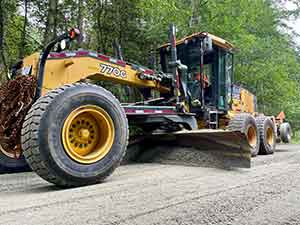Grading Operations FAQs
Mainroad experiences a high frequency of questions from the public concerning grading operations in Central and North Vancouver Island Service Areas. This resource aims to answer most frequently asked questions and if you still have questions or would like to report feedback, please call Mainroad’s 24-hour public information hotline. Mainroad’s Call Centre is available 24 hours a day, 7 days a week – the operator will record all public feedback and forward the information to our crews on shift to respond, as well as dispatch additional personnel, and update Drive BC.
What is grading?
 Road grading is a specific highway maintenance activity to restore the driving surface and drainage of a dirt or gravel highway. A motor grader, commonly referred to as a road grader, or simply a blade, is a form of heavy equipment with a long blade used to create a flat surface during grading. The grader operator will remove potholes and other irregularities by cutting the surface of the dirt or gravel highway or filling it with material moved back and forth across the road creating a smooth surface to establish a proper road cross section.
Road grading is a specific highway maintenance activity to restore the driving surface and drainage of a dirt or gravel highway. A motor grader, commonly referred to as a road grader, or simply a blade, is a form of heavy equipment with a long blade used to create a flat surface during grading. The grader operator will remove potholes and other irregularities by cutting the surface of the dirt or gravel highway or filling it with material moved back and forth across the road creating a smooth surface to establish a proper road cross section.
Why does Mainroad grade roads?
Mainroad is responsible for servicing the Ministry of Transportation & Infrastructure highway maintenance contract for Central Island known as Service Area 2 and North Island known as Service Area 3. As part of our highway maintenance contract with the Province, Mainroad performs grading operations on dirt and gravel highways. This maintenance ensures that there is effective drainage from the road surface and that surface irregularities are corrected resulting in a smooth driving surface.
What is the difference between grading and reshaping a road surface?
There are two different types of grading activities that Mainroad performs on dirt and gravel highways.
Grading involves the machine blading of the existing surface to correct deformities and
re-establish a smooth road surface (sometimes referred to as “tight blading”)
Grading Reshaping is a grading activity that requires the machine blading of dirt and gravel highways from ditch line to ditch line. More specifically, grading re-shaping is meant to re-establish the proper shape of the highway including the outside edges and the crown and to remove surface irregularities. Re-shaping also brings the aggregate and road fines back to the gravel or dirt surface from the side slopes and ditches. Grading-reshaping requires a deeper cut than the regular grading activity.
Where does Mainroad perform grading operations?
Mainroad performs grading and re-shaping on all gravel and dirt highways throughout the Central Island Service Area 2. The Central Island Service Area includes all dirt and gravel highways many of which are located in more remote locations, including Gulf Islands; Gabriola, Mudge, De Courcy and Lasqueti.
Mainroad also performs grading and re-shaping on all Provincial (not Forestry) gravel highways throughout the North Island Service Area 3. The North Island Service Area includes all gravel roads in many of the remote communities of North Vancouver Island as well as the area surrounding the Comox Valley and Gulf Islands; Quadra, Cortes, Denman, and Hornby.
How many dirt and gravel highways does Mainroad perform maintenance on in the Service Area?
For the North Island Service Area, Mainroad maintains 481 separate gravel highways. This equates to 852 lane kilometers of gravel highway. Mainroad operates five (5) Grader Units year-round as well as multiple subcontracted grading operations. These graders perform grading, reshaping, as well as snow removal during winter operations.
When does Mainroad perform grading operations?
When can Mainroad not perform grading operations?
There are road and weather conditions when grading operations is not practical or efficient to complete – these conditions range from weather events, road surface conditions, or environmental conditions.
Weather events: during snow events, grading equipment is deployed to winter highway maintenance including snow removal operations while rain events prevent proper road grading or re shaping as gravel surfaces can easily wash away.
Road surface conditions: the base of the dirt or gravel highway surface is saturated from excess moisture, or the road has been recently base stabilized.
Environmental conditions: A situation when environmental conditions cause the provincial fire danger rating to climb.



